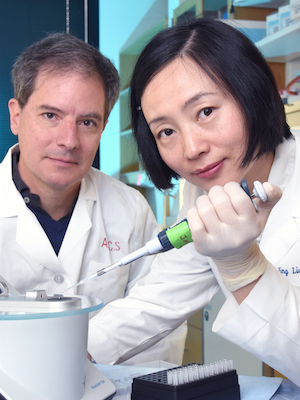Scientists find that it pays to count RNA
DALLAS – February 2017 – UT Southwestern Medical Center researchers have found that a small number of mutated RNA molecules can have major consequences on neurodegenerative conditions such as amyotrophic lateral sclerosis (ALS) and frontotemporal dementia (FTD).
Each year, about 5,000 people in the U.S. are diagnosed with ALS, also known as Lou Gehrig’s disease. Only a small percentage of cases have a known genetic cause. Five to 10 percent of ALS patients have a family history of ALS or FTD, according to the U.S. National Library of Medicine. ALS is a fatal condition marked by the death of brain and spinal cord neurons that govern movement. FTD is a common form of dementia that affects personality, behavior, and language.

In 2011, a gene was discovered linked to both ALS and FTD. Today, mutations in the chromosome 9 open reading frame 72 (C9orf72) gene are considered the biggest known genetic contributor to familial ALS and familial FTD, said Dr. David Corey, Professor of Pharmacology and Biochemistry, holder of the Rusty Kelley Professorship in Medical Science, and senior author of the study published recently in Cell Chemical Biology.
Instead of the patterns in the normal gene, which contains a segment with fewer than 24 repeats of a GGGGCC sequence of the DNA code, mutant C9orf72 genes contain 700 to 1,600 repeats of that sequence. There is also an antisense mutation, a CCCCGG repeat, he said. Both mutations were examined in this study using cells from ALS patients.
The mutations in the gene lead to production of mutant RNA. But just how the mutant RNA causes disease is unclear, and the UT Southwestern researchers decided to do something uncommon: count the number of altered RNA molecules to provide a foundation for understanding how disease begins.
“We found that cells have only a handful of copies of mutant RNA molecules. On average, diseased cells had less than four of these bad RNAs and, in many cells, the mutant RNA molecules cannot even be detected,” Dr. Corey said. The researchers also found that those few RNA molecules formed foci (specific structures within the nucleus of cells) and that contrary to expectations, foci contained only one RNA molecule, not many.
“This feature is important because knowing the organization of foci will allow us to better understand the underlying mechanism causing ALS and FTD and, we hope, eventually lead to new treatment strategies for both diseases,” he said. “We conclude that tiny numbers of RNA molecules can have a great impact on serious neurodegenerative disease.”




